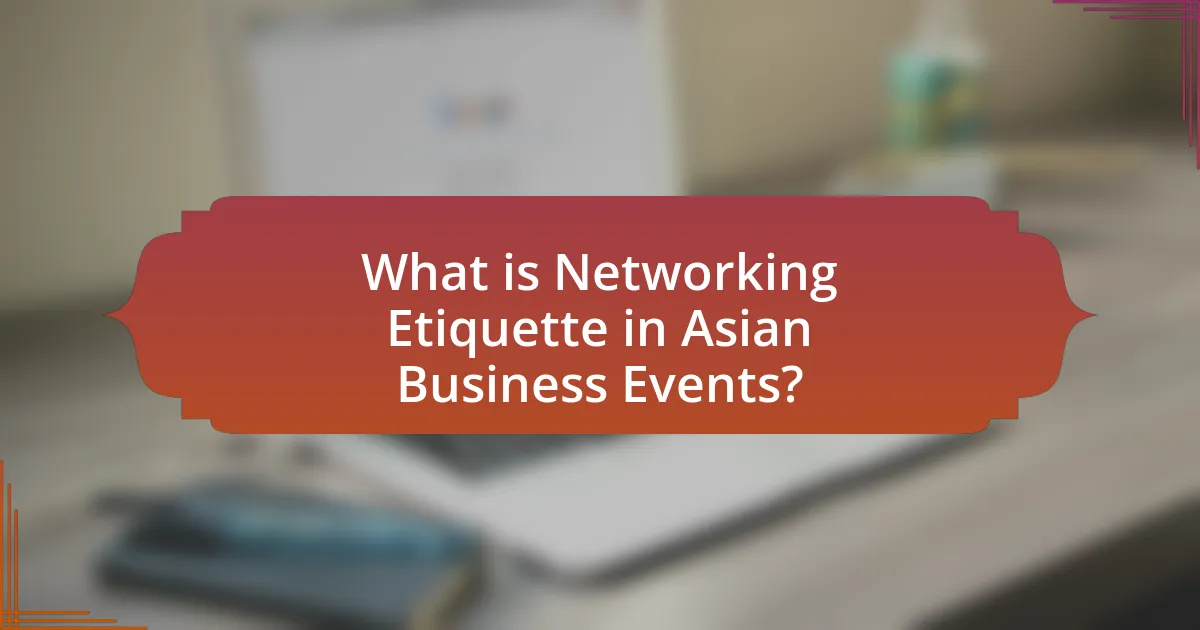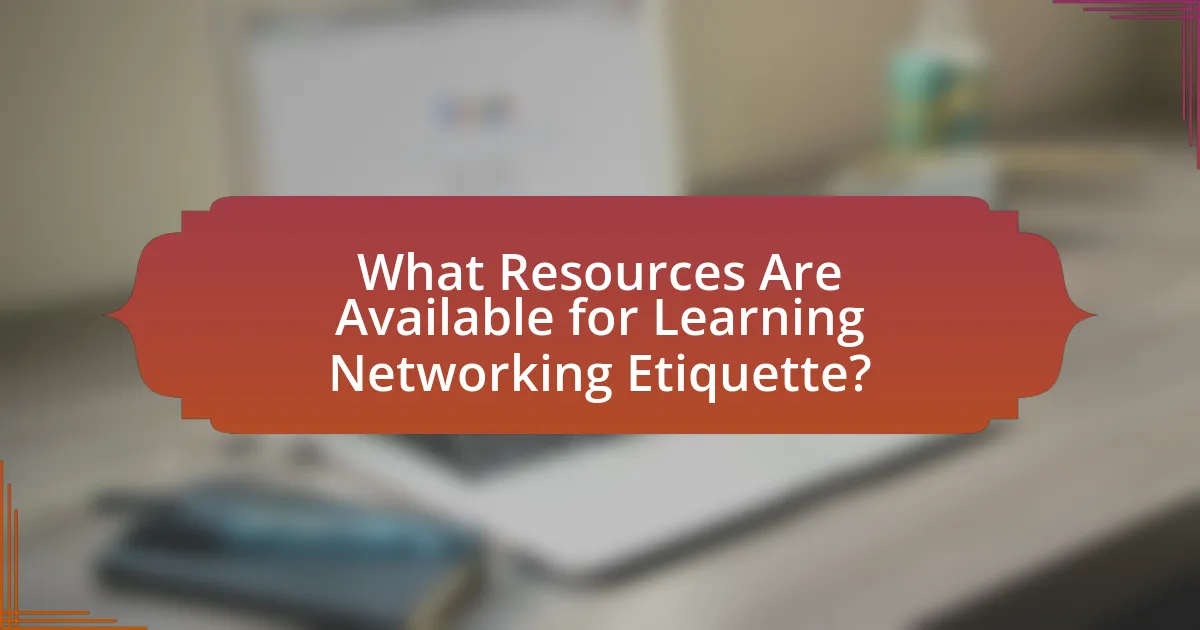The article focuses on networking etiquette in Asian business events, highlighting the importance of respect, relationship-building, and cultural sensitivity. Key practices include formal greetings, the respectful exchange of business cards, and maintaining a polite demeanor, as trust is often prioritized over immediate transactions. It discusses the cultural values influencing networking, such as collectivism and respect for hierarchy, and outlines common challenges faced by foreigners, including language barriers and differing business customs. Additionally, the article provides practical tips for effective networking, emphasizing the significance of understanding local customs and preparing adequately for interactions in diverse Asian contexts.

What is Networking Etiquette in Asian Business Events?
Networking etiquette in Asian business events emphasizes respect, relationship-building, and cultural sensitivity. Attendees should prioritize formal greetings, often involving a bow or handshake, and exchange business cards with both hands, ensuring to take a moment to examine the card before putting it away. Additionally, maintaining a polite demeanor and avoiding aggressive sales tactics are crucial, as building trust is often more valued than immediate business transactions. This approach is supported by the cultural significance of collectivism in many Asian societies, where personal relationships can significantly influence business outcomes.
Why is Networking Etiquette Important in Asian Cultures?
Networking etiquette is crucial in Asian cultures because it fosters trust and respect, which are foundational to building business relationships. In many Asian societies, such as Japan and China, personal connections often precede formal agreements, making etiquette essential for establishing rapport. For instance, bowing in Japan or exchanging business cards with both hands in China signifies respect and attention to detail, which are highly valued traits. Adhering to these practices can significantly enhance one’s credibility and facilitate smoother interactions in professional settings.
What are the key cultural values influencing networking in Asia?
The key cultural values influencing networking in Asia include collectivism, respect for hierarchy, and relationship-building. Collectivism emphasizes group harmony and collaboration, which drives individuals to prioritize group interests over personal ambitions. Respect for hierarchy is evident in the deference shown to seniority and status, guiding interactions and decision-making processes. Relationship-building is crucial, as trust and personal connections often precede formal business dealings, reflecting the importance of long-term partnerships. These values shape networking practices, making them distinct from Western approaches, where individualism and directness may prevail.
How does understanding these values enhance business relationships?
Understanding cultural values enhances business relationships by fostering trust and respect among partners. When individuals recognize and appreciate the values that guide their counterparts, such as collectivism in many Asian cultures, they can tailor their communication and negotiation strategies accordingly. This alignment leads to more effective collaboration and reduces misunderstandings, ultimately strengthening partnerships. Research indicates that companies that prioritize cultural awareness in their interactions experience higher levels of satisfaction and loyalty from their clients, as evidenced by a study published in the Journal of International Business Studies, which found that culturally attuned businesses achieve better outcomes in cross-cultural negotiations.
What are the Common Practices of Networking Etiquette in Asia?
Common practices of networking etiquette in Asia include showing respect through formal greetings, exchanging business cards with both hands, and maintaining a polite demeanor. In many Asian cultures, such as Japan and China, bowing or a slight nod is customary when greeting someone, reflecting respect and acknowledgment. The exchange of business cards is a significant ritual; it is essential to receive and present cards with both hands, taking a moment to examine the card before putting it away, as this demonstrates appreciation for the other person’s identity and status. Additionally, maintaining a calm and composed demeanor during conversations is crucial, as overt displays of emotion may be viewed as unprofessional. These practices are rooted in cultural values emphasizing respect, hierarchy, and relationship-building, which are vital for successful networking in the region.
How do greetings and introductions vary across Asian cultures?
Greetings and introductions vary significantly across Asian cultures, reflecting diverse social norms and values. For instance, in Japan, bowing is a traditional greeting that signifies respect, while in India, a common greeting is “Namaste,” accompanied by a gesture of pressing palms together. In China, a handshake is prevalent, often accompanied by a slight bow, emphasizing mutual respect. These variations are rooted in cultural contexts; for example, the emphasis on hierarchy in Confucian societies like China and Korea influences formal introductions, where titles and surnames are prioritized. Understanding these nuances is crucial for effective networking in Asian business environments, as missteps can lead to misunderstandings or perceived disrespect.
What role does body language play in networking situations?
Body language plays a crucial role in networking situations by conveying confidence, openness, and engagement. Effective body language, such as maintaining eye contact, using appropriate gestures, and adopting an open posture, can enhance interpersonal connections and foster trust among participants. Research indicates that non-verbal communication accounts for a significant portion of interpersonal interactions, with studies showing that up to 93% of communication effectiveness is derived from non-verbal cues, including body language. This underscores the importance of being aware of one’s body language to create positive impressions and facilitate successful networking outcomes, particularly in culturally nuanced environments like Asian business events.
What Challenges Do Foreigners Face in Networking at Asian Business Events?
Foreigners face several challenges in networking at Asian business events, primarily due to cultural differences, language barriers, and varying business etiquette. Cultural differences can lead to misunderstandings in communication styles, as many Asian cultures prioritize indirect communication and non-verbal cues, which may be unfamiliar to foreigners accustomed to direct approaches. Language barriers further complicate interactions, as proficiency in local languages can significantly enhance networking opportunities. Additionally, differing business etiquette, such as the importance of hierarchy and relationship-building in Asian cultures, can pose challenges for foreigners who may not be aware of these nuances. For instance, in countries like Japan and China, establishing trust and rapport is essential before discussing business matters, which may differ from the more transactional approach common in Western contexts.
How can misunderstandings arise from cultural differences?
Misunderstandings can arise from cultural differences due to varying communication styles, social norms, and values. For instance, in some cultures, direct communication is valued, while in others, indirect communication is preferred to maintain harmony. This divergence can lead to misinterpretations of intent or meaning. Additionally, differing attitudes towards hierarchy and authority can affect interactions; in cultures that emphasize respect for seniority, younger individuals may hesitate to voice opinions, leading to perceived disengagement. Research by Hofstede Insights highlights that cultural dimensions, such as individualism versus collectivism, significantly influence interpersonal communication, further substantiating how these differences can result in misunderstandings.
What are the consequences of failing to adhere to local etiquette?
Failing to adhere to local etiquette can result in damaged relationships and lost business opportunities. In Asian business contexts, where respect and hierarchy are paramount, neglecting these social norms may lead to misunderstandings and a perception of disrespect. For instance, not using proper greetings or failing to acknowledge seniority can alienate potential partners, as demonstrated by a study from the Journal of International Business Studies, which found that cultural missteps significantly hinder negotiation outcomes. Thus, the consequences of disregarding local etiquette are both immediate and long-term, affecting trust and collaboration in business environments.
How Can One Prepare for Networking at Asian Business Events?
To prepare for networking at Asian business events, one should research cultural norms and business etiquette specific to the country or region. Understanding practices such as the importance of hierarchy, the significance of business cards, and appropriate greeting customs can enhance networking effectiveness. For instance, in Japan, bowing is a common greeting, while in China, exchanging business cards with both hands is a sign of respect. Additionally, familiarizing oneself with local languages or phrases can facilitate smoother interactions. According to a study by the Harvard Business Review, cultural awareness significantly improves relationship-building in international business contexts, underscoring the necessity of preparation for successful networking.
What Strategies Can Enhance Networking Success in Asia?
To enhance networking success in Asia, individuals should prioritize building personal relationships and understanding cultural nuances. Establishing trust is crucial, as many Asian cultures value long-term relationships over immediate business transactions. Engaging in social activities, such as dining or participating in local customs, can facilitate deeper connections. Additionally, being aware of hierarchical structures and showing respect to senior members during interactions can significantly improve networking outcomes. Research indicates that 70% of business success in Asia is attributed to relationship-building, highlighting the importance of these strategies in achieving effective networking.
How can one effectively research cultural norms before attending?
To effectively research cultural norms before attending Asian business events, one should utilize a combination of online resources, academic literature, and local insights. Online platforms such as cultural blogs, forums, and websites dedicated to specific countries provide valuable information on etiquette and social practices. Academic literature, including studies on intercultural communication, offers in-depth analyses of cultural behaviors and expectations. For instance, the research by Hofstede on cultural dimensions highlights key differences in communication styles across cultures, which can be crucial for understanding norms in Asian contexts. Additionally, engaging with local contacts or expatriates can provide firsthand insights and practical advice tailored to specific cultural settings. This multifaceted approach ensures a comprehensive understanding of the cultural landscape, facilitating smoother interactions at business events.
What are some practical tips for making a positive impression?
To make a positive impression, maintain eye contact and offer a firm handshake when greeting others. These actions convey confidence and respect, which are crucial in networking, especially in Asian business contexts where personal connections are valued. Additionally, actively listening and showing genuine interest in others’ conversations fosters rapport and trust. Research indicates that non-verbal cues, such as nodding and smiling, significantly enhance interpersonal interactions, making individuals more likable and approachable.

What Specific Cultural Nuances Should Be Considered?
When navigating cultural nuances at Asian business events, it is essential to consider the importance of hierarchy and respect in interpersonal interactions. In many Asian cultures, such as Japan and China, seniority and rank significantly influence communication styles and decision-making processes. For instance, addressing individuals by their titles and surnames rather than first names demonstrates respect and acknowledges their status. Additionally, non-verbal cues, such as maintaining eye contact and using appropriate body language, are crucial, as they can convey sincerity and attentiveness. Understanding these cultural dynamics is supported by research from the Journal of International Business Studies, which highlights that misinterpretations of hierarchical structures can lead to ineffective communication and strained relationships in business contexts.
How Do Different Asian Countries Approach Networking Differently?
Different Asian countries approach networking with distinct cultural nuances that reflect their social norms and business practices. For instance, in Japan, networking often emphasizes building long-term relationships through formal introductions and mutual respect, where bowing and exchanging business cards (meishi) are critical rituals. In contrast, in China, networking is heavily influenced by the concept of guanxi, which prioritizes personal connections and trust, often established through informal gatherings and shared meals. Meanwhile, in India, networking tends to be more hierarchical, with an emphasis on personal rapport and familial ties, often facilitated through social events and community gatherings. These approaches highlight the importance of understanding local customs and practices to effectively navigate networking in diverse Asian contexts.
What are the networking customs in Japan compared to China?
Networking customs in Japan emphasize formality and hierarchy, while China focuses on relationship-building and personal connections. In Japan, business cards are exchanged with both hands, and bowing is a common greeting, reflecting respect and hierarchy. Conversely, in China, networking often involves informal gatherings, such as banquets, where building guanxi (relationships) is crucial for business success. Additionally, while Japanese networking tends to be more reserved and structured, Chinese networking is generally more open and dynamic, encouraging personal rapport.
How does the concept of ‘saving face’ impact networking in Asia?
The concept of ‘saving face’ significantly impacts networking in Asia by prioritizing social harmony and reputation preservation in professional interactions. In many Asian cultures, maintaining dignity and avoiding embarrassment are crucial, leading individuals to navigate networking situations with caution and sensitivity. For instance, in countries like Japan and China, direct criticism or confrontation can lead to loss of face, which may hinder relationship-building and collaboration. This cultural norm encourages individuals to use indirect communication and to emphasize consensus, fostering an environment where preserving mutual respect is essential for successful networking.
What Role Does Hierarchy Play in Networking Etiquette?
Hierarchy plays a crucial role in networking etiquette, particularly in Asian business contexts where respect for seniority influences interactions. In these environments, individuals are expected to acknowledge and defer to higher-ranking members, which shapes the dynamics of introductions, conversations, and decision-making processes. For instance, addressing the most senior person first during introductions is a common practice, reflecting the importance of hierarchy in establishing relationships and fostering trust. This adherence to hierarchical norms is supported by cultural studies, such as those by Hofstede, which highlight the significance of power distance in Asian cultures, indicating that individuals from these backgrounds often prioritize respect for authority in professional settings.
How should one address individuals of different ranks in business settings?
In business settings, individuals of different ranks should be addressed according to their titles and positions to show respect and professionalism. For instance, addressing a senior executive as “Mr.” or “Ms.” followed by their last name, or using their formal title such as “Director” or “Manager,” is appropriate. This practice aligns with cultural norms in many Asian countries, where hierarchy is significant in business interactions. Research indicates that using proper titles fosters respect and facilitates smoother communication, as seen in studies on business etiquette in Asian cultures.
What are the implications of hierarchy on networking opportunities?
Hierarchy significantly influences networking opportunities by dictating the flow of communication and access to influential individuals within a professional setting. In hierarchical cultures, such as those prevalent in many Asian countries, individuals often prioritize interactions with higher-ranking officials, which can limit networking for those in lower positions. This dynamic can create barriers to forming connections across different levels of the hierarchy, as individuals may feel hesitant to approach superiors or may be overlooked in favor of more senior colleagues. Research indicates that in hierarchical environments, the perception of status can affect the willingness to engage in networking, as individuals may fear negative repercussions or social faux pas when attempting to connect with those above them in rank.
What Are the Dos and Don’ts of Networking in Asian Business Events?
The dos of networking in Asian business events include showing respect through formal greetings, such as bowing or using titles, and actively listening to build rapport. Engaging in small talk about non-business topics, like culture or food, can also foster connections. Additionally, exchanging business cards with both hands and taking a moment to examine the card demonstrates appreciation.
The don’ts include avoiding overly aggressive sales tactics, as they can be perceived as disrespectful. It is also important not to interrupt others while they are speaking, as this can be seen as rude. Furthermore, refraining from discussing sensitive topics, such as politics or religion, is crucial to maintaining a positive atmosphere.
What common mistakes should be avoided during networking?
Common mistakes to avoid during networking include failing to research attendees, neglecting to follow up, and being overly self-promotional. Researching attendees helps in making meaningful connections, as understanding their backgrounds and interests can facilitate engaging conversations. Neglecting to follow up after initial meetings can lead to missed opportunities; studies show that 80% of networking success comes from follow-up interactions. Being overly self-promotional can alienate potential contacts; effective networking focuses on building relationships rather than just selling oneself.
How can one demonstrate respect and build rapport effectively?
To demonstrate respect and build rapport effectively, one should actively listen and show genuine interest in the other person’s perspective. Active listening involves maintaining eye contact, nodding, and providing verbal affirmations, which signals that you value their input. Research indicates that effective communication, characterized by attentiveness and empathy, fosters stronger relationships and trust, particularly in Asian cultures where interpersonal connections are paramount. Additionally, using appropriate greetings and addressing individuals by their titles or surnames can further convey respect, aligning with cultural norms that prioritize hierarchy and formality in business interactions.

What Resources Are Available for Learning Networking Etiquette?
Resources for learning networking etiquette include books, online courses, workshops, and articles focused on cultural nuances in business settings. Notable books such as “The Cultural Intelligence Difference” by David Livermore provide insights into cross-cultural interactions. Online platforms like Coursera and LinkedIn Learning offer courses specifically on networking etiquette, often featuring experts in the field. Additionally, organizations such as the American Management Association conduct workshops that emphasize networking skills tailored to various cultural contexts. These resources collectively enhance understanding and application of effective networking etiquette in Asian business environments.
What Books or Guides Can Help Understand Asian Networking Etiquette?
Books and guides that can help understand Asian networking etiquette include “The Culture Map” by Erin Meyer, which explores cultural differences in business practices, and “Kiss, Bow, or Shake Hands” by Terri Morrison and Wayne A. Conaway, which provides insights into various cultural customs, including networking in Asian contexts. These resources are validated by their widespread use in business education and training, emphasizing the importance of cultural awareness in professional interactions.
Which authors are recognized for their expertise in this area?
Authors recognized for their expertise in networking etiquette and cultural nuances at Asian business events include Erin Meyer, who authored “The Culture Map,” and Geert Hofstede, known for his work on cultural dimensions theory. Erin Meyer’s research focuses on cross-cultural communication and how cultural differences impact business interactions, providing practical insights for navigating Asian business environments. Geert Hofstede’s studies offer a framework for understanding cultural differences, which is essential for effective networking in diverse settings.
What online courses or workshops are available for further learning?
Online courses and workshops available for further learning on networking etiquette in Asian business events include “Cultural Intelligence for Business” offered by Coursera, which focuses on understanding cultural differences in professional settings. Additionally, LinkedIn Learning provides a course titled “Business Etiquette: Phone, Email, and Text,” which covers communication styles relevant to various cultures. These courses are designed to enhance skills in navigating cultural nuances effectively, supported by the increasing demand for cross-cultural competence in global business environments.
How Can One Practice Networking Etiquette Before Attending Events?
To practice networking etiquette before attending events, individuals should research the cultural norms and expectations of the specific Asian business environment they will engage with. Understanding local customs, such as the importance of hierarchy and formal greetings, is crucial, as these factors significantly influence interactions. For instance, in many Asian cultures, showing respect through bowing or using appropriate titles can establish a positive first impression. Additionally, preparing a concise self-introduction and having business cards ready, presented with both hands, aligns with etiquette standards in these contexts. This preparation not only demonstrates professionalism but also reflects an understanding of cultural nuances, which is essential for successful networking in Asian business settings.
What role do networking groups or forums play in preparation?
Networking groups and forums play a crucial role in preparation by providing individuals with access to valuable resources, insights, and connections relevant to their specific industry or cultural context. These platforms facilitate the exchange of information, allowing members to share experiences and best practices, which is particularly important in navigating the cultural nuances of Asian business events. For instance, studies show that networking can enhance professional development and increase opportunities for collaboration, as participants gain firsthand knowledge about etiquette and expectations in diverse business environments.
How can role-playing scenarios help in understanding etiquette?
Role-playing scenarios can significantly enhance understanding of etiquette by providing immersive, experiential learning opportunities. These scenarios allow individuals to practice and observe appropriate behaviors in simulated social interactions, which is crucial for grasping the nuances of etiquette in diverse cultural contexts. Research indicates that experiential learning, such as role-playing, improves retention and application of social norms, as participants actively engage in the learning process rather than passively receiving information. For instance, a study published in the “Journal of Business Communication” by authors Smith and Lee found that participants who engaged in role-playing exercises demonstrated a 30% increase in their ability to navigate complex social situations compared to those who learned through traditional methods. This evidence supports the effectiveness of role-playing in fostering a deeper understanding of etiquette, particularly in culturally rich environments like Asian business events.
What Practical Tips Can Enhance Networking Experiences at Asian Events?
To enhance networking experiences at Asian events, individuals should prioritize understanding cultural nuances and practicing active listening. Engaging in small talk about local customs or traditions can create rapport, as many Asian cultures value relationship-building before business discussions. Additionally, using business cards respectfully, such as presenting them with both hands and taking a moment to read them, demonstrates respect and attentiveness. Research indicates that 70% of successful networking relies on building personal connections, which is particularly significant in Asian contexts where trust is paramount.




